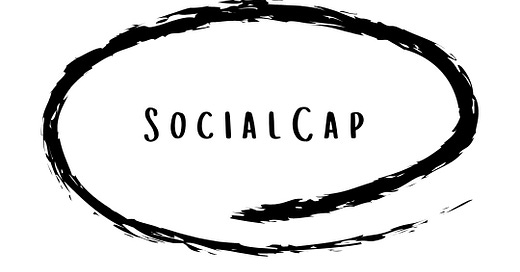Greetings!
On This Monday’s Episode of my podcast Your Money Guide on the Side:
How I Would Invest $1,000,000 - 3 Approaches, 3 Stories, and 1 Question to Simplify Your life. If you have been thinking through your own investment approach, or you’ve been thinking about thinking through your own investment approach, this episode is a good place to start, as it will consider three simplified approaches to how we might invest our assets based on our personal wants, needs, risk tolerance, time horizon, etc. But more importantly, it will provide you with the only question (yes, one question) I ask myself when trying to decide where to put money.
As always, if you like where the podcast is going, please consider leaving a review—it helps others find the show; and if you have feedback on where it should go or what’s currently garbage, write to me at socialcapconnect@gmail.com—I read and internalize every message, even if I can’t reply to all.
Listen on Apple | Listen on Spotify | Listen on Amazon
This Week: How I Would Invest $1,000,000
For those of you who can’t tune into the podcast this week, or just want the TL;DR notes, see below.
The number one thing I want you to take-away this week: appropriate asset allocation has far less to do with age than you/we have been taught. You are not, and you never will be, the same investor as the 50 year old sitting next to you.
1. The Growth Portfolio (aka, let it ride)
This person is comfortable with risk, invests for the long term, and isn’t checking their portfolio every five minutes (or if they are, they’re definitely not acting upon whatever emotions pop up!). They’re not scared of volatility; they see it as the price of admission for outsized returns.
How I would invest $1,000,000 for growth:
70% Public Equities (broad market, low-cost, and tilt toward small-cap or international emerging)
20% Private Equities (see SocialReCap #45 for additional considerations here, but over long enough time horizon, this is how endowments and institutions tend to beat the broad public markets)
10% Cash or Bonds (you all know I don’t love bonds, but they do provide a slight down side hedge over time and exposure to yet another asset class; I would choose highly liquid short term on my end)
This isn’t reckless, even at the age of 60…it’s intentional. My father is 76 years old and loves this approach because he is ok with risk and is also prioritizing long term legacy planning.
2. The Balanced Approach (aka, I like growth but I HATE the idea of loss, too)
This person values growth but also needs to know that a big market drop won’t wreck their plans, especially if they’re thinking about first few years approaching or soon after retirement. Think: entrepreneurs, early retirees, or people who say “I’m cautiously optimistic” a lot.
Breakdown:
60% Equities (You’ll notice this is always going to be at the core of my strategies. I am currently 83% invested in equities as a 42 year old)
20% Bonds (I would lean on Munis more here to try to capture tax advantages)
10% Real Assets (REITs can serve as a nice balance in this type of plan)
10% Cash (the balanced approach needs the short term liquidity, so you can sleep at night)
This mix creates enough upside to build wealth, but enough stability to avoid panic selling in a downturn with some non-correlated asset class exposure.
3. The Conservative Cash Flow Investor (aka, I just want my money to give me money)
Here’s the person who wants income, stability, and clarity. Maybe they’re done accumulating, or maybe they’re just wired to prioritize peace of mind over performance. The key here, if you are going with this approach (and why I personally don’t love this approach) is that you’re not just battling with a one year timeline but rather a 20-30 year timeline and inflation doesn’t retire when you do, so that 4% return you’re loving isn’t necessarily giving you what you want over a long enough horizon beyond maintaining purchasing power.
Breakdown:
40% Bonds & Fixed Income
30% Dividend Stocks (these tend to do better than growth stocks in downturns)
20% Real Assets or Annuity Alternatives (no, I don’t sell annuities, and no, I don’t love them, but again, I’m not you.)
10% Cash or HYSA
This portfolio is designed to produce steady cash flow while preserving capital (kind of). Not flashy. But solid, predictable, and practical (kind of).
The Real Point?
Your portfolio isn’t a reflection of your age. It’s a mirror for your values, temperament, and goals. And the only “wrong” strategy is the one you can’t stick with, or the one that doesn’t fit who you are. Don’t play someone else’s game just because you’ve been told, “Well, Scott, that’s how 70 year olds invest!” —- Nonsense.
Me? My money script has always leaned towards highly risk tolerant and long term oriented. I am currently 74% invested in domestic index funds and ETFs, 9% invested in emerging market index funds and ETFs, and 17% in short term cash equivalents for quarterly tax purposes and potential buying opportunities.
As always, hope this provides you with something to think about throughout the week, and the podcast goes into way more detail on each of the above.
Tyler
Your Money Guide on the Side






As a soon, very soon, to be retired person wandering the globe, I really appreciate how you bring clarity to financial decisions. Thank you for all you bring!
Thanks for clarifying the time line part of the equation. That is helpful! And PS LOVE the podcasts (all of them so far!)